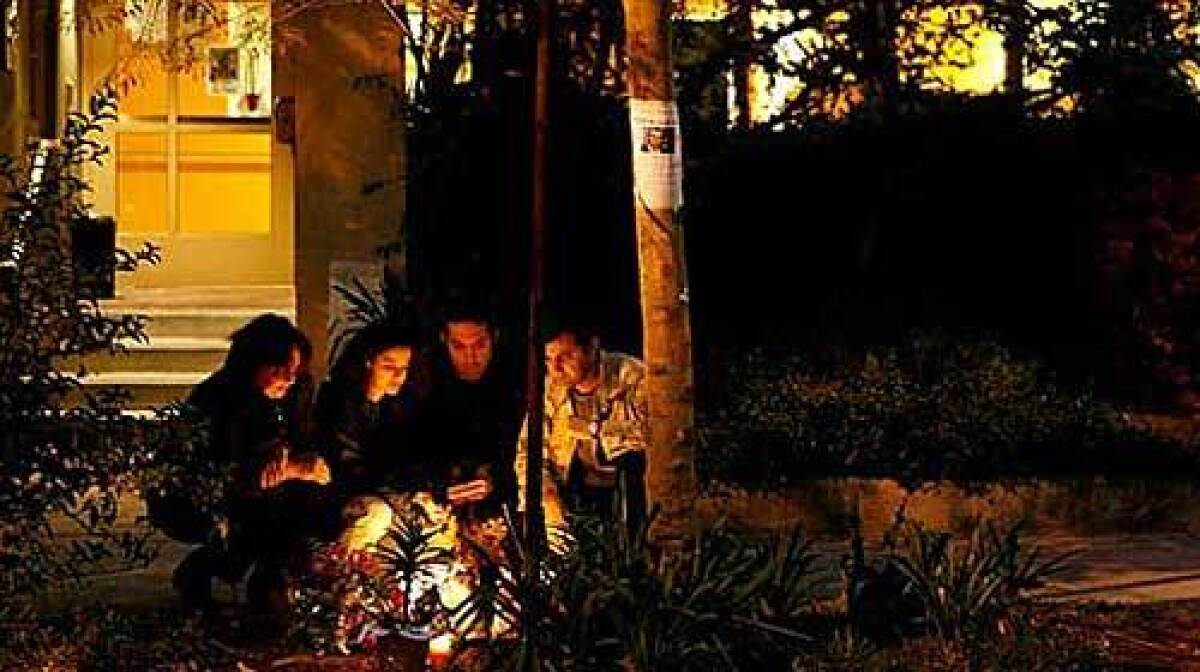Stabbing death shakes up L.A.-West Hollywood neighborhood

- Share via
She’d tell him, time and again: Don’t walk at night. The place has changed. It’s not safe. They’d been married, though, for 44 years. After a certain point, it wasn’t really a conversation; it was like a song they’d played a thousand times, enjoyed more for routine than anything else.
“Ne perezhivaitye,” he’d tell her. “Don’t worry.”
He left their little apartment in West Hollywood at 9 p.m. March 9, a Sunday, walking out past a bookshelf full of all the dictionaries required of a Kazakhstani in L.A.: one in English, one in Russian, a Russian-to-English, a Spanish-to-English.
Katan Khaimov was a 70-year-old diabetic, but he was in great shape. He often walked for an hour or more, so his family didn’t worry at first. But when 11 p.m. passed, his wife, Tamara, went looking for him.
On the west side of Poinsettia Park, below Santa Monica Boulevard, she pulled her car next to an intersection that had been cordoned off with yellow crime-scene tape.
“What happened here?” she asked a police officer.
“Who are you?” he said.
“I’m looking for my husband.”
The fact that Khaimov was slain has been hard enough for his neighborhood to accept. But the awful coda of his life has added to the soul-searching. Neighbors, it turns out, heard him dying -- crying for help after being stabbed in the stomach -- for more than an hour before anyone called the police.
Officials say several residents in Khaimov’s neighborhood, which straddles the cities of West Hollywood and Los Angeles, believed his moans were the sounds of a vagrant. Cars also passed by while he was lying next to the street, still alive, his head and one arm flopped over the curb.
“Nobody cared,” said his 26-year-old daughter, Olga, the youngest of his four children. “To think that people didn’t answer a man’s cries for help. . . . Even if it is a bum. So what? Call the cops. It’s a person, a human being.”
There have been no arrests. Khaimov was not robbed, and police have declined to speculate about what might have motivated his attacker. It’s unclear how many people saw or heard Khaimov that night, and it’s unclear whether he could have been saved had he been taken to a hospital earlier.
Regardless, there is a sense here that Khaimov was failed, somehow.
“It is a shocking thing that nobody went out to help,” said 47-year-old Paul Lerner, a public safety advocate and a healthcare marketing consultant who has lived in the area for five years.
The neighborhood has long fancied itself something of an urban tribe, where Russian-speaking Jews like Khaimov shared the narrow, leafy streets and the boxy apartment buildings with fixed-income seniors, club-hopping hipsters and young gays.
It was never going to be mistaken for Mayberry, but it was -- or was supposed to be -- a place where people took care of one another. A place where, on your nightly constitutional, you might encounter misfits and oddballs, but not murderers.
Katan Khaimov and his family lived in a house he built with his father in a factory village in Kazakhstan, north of the Uzbekistan capital of Tashkent. He was the head of an engineering company and helped oversee the construction of gymnasiums and hospitals, but it was not enough.
“The way it worked was that you did not get paid well unless you stole. And he was an honest man,” Olga Khaimova said. When the United States offered his family immigration visas in 1995, he jumped at the chance.
“He moved here for us,” Olga Khaimova said.
He pushed the value of hard work and education on his four children. It worked -- two grown daughters, who now live in Israel, are a music teacher and a doctor; Olga’s brother is a pharmacist; and Olga is studying to become a nurse practitioner.
Khaimov, meanwhile, found that his educational degrees did not translate in the United States. His days of being a construction engineer were behind him, so he became a renaissance man instead.
He sang baritone in a community choir. He kayaked the Colorado River. He grew tomatoes and cucumbers in a community garden. He was nice to everyone, even Olga’s 4-pound iguana, T-Rex, whom he allowed to crawl under his sweater on cold days.
It was a simple life. It was what he wanted. He was not rich. He had no cellphone. He had no driver’s license, which is one reason he walked, sometimes three times a day -- to the market, to the local parks, to Runyon Canyon, a popular hiking area.
“He was just a wonderful man,” his wife said the other day, her eyes facing the floor, her voice nearly a whisper. “He liked to live.”
Within the last year or so, his neighborhood began to change. Indeed, some argue that no one should be blamed for failing to come to Khaimov’s aid because the neighborhood has been inundated with a gritty cast of lost souls -- mentally ill and homeless people, junkies and prostitutes.
“I live next to an alley,” said Melvy Murguia, 45, a business and career coach who has lived in the neighborhood nearly her entire life and has become, of late, a public safety advocate. “Sometimes I hear sexual transactions taking place, and I’m constantly hearing screams and yelling. Do I look out every single time? No. I would just be glued to the window.”
Some homeless and mentally ill people have begun drifting here from downtown L.A., which is undergoing rapid change with new, pricey lofts and new enforcement of loitering laws. Drug addicts have followed, some drawn by a nonprofit food kitchen and needle exchange program off Santa Monica Boulevard, on the other side of Poinsettia Park from Khaimov’s apartment.
Some homeless people have taken up residence in Poinsettia Park.At night, it is not uncommon to see prostitutes trying to flag down cars. Residents also say public urination and open-air drug dealing -- and use -- are routine. There are several new nightclubs in the area too, which have brought a wave of young visitors late at night. A couple of purse-snatchings have been reported recently.
Major crime in the Los Angeles Police Department’s Hollywood Division has actually dropped 10% in the last year, said Capt. Clay Farrell, the division’s commanding officer. Residents, however, say much of the new criminal activity is not the sort that shows up in major crime statistics.
And Farrell acknowledged that residents’ perception that they are less safe -- “right or wrong” -- is all that matters. Residents are often forced to weigh their concern for others against their own safety, and many times, Farrell said, “people opt out” -- opt not to get involved.
“So, no,” Farrell said, “I was not surprised.”
Khaimov’s death has sparked a surge in civic interest in the neighborhood. More than 300 people turned out for a recent public meeting to talk about crime. There is a new neighborhood watch program, and activists like Murguia and Lerner have begun enlisting block captains -- and communicating more directly with police officers -- to help keep tabs on criminal activity.
“Our whole city is in something of a breakdown,” Murguia said. “We all need to be accountable.”
Still, taking back these streets suddenly feels like a daunting notion. Even Khaimov’s relatives say they understand why no one would want to go out these days into the dead of night to try to follow the sounds of a dying man.
“They hear it every day,” Olga Khaimova said. “Can you blame them?”
More to Read
Sign up for Essential California
The most important California stories and recommendations in your inbox every morning.
You may occasionally receive promotional content from the Los Angeles Times.










